| |
SupraChem Lab overall concept and approach
The strategic objective of the SupraChem Lab Project is to unlock and foster excellent research in PPIMC IntelCentre by setting up a strong research group in the field of hybrid materials for adaptive self-organized supramolecular structures. When setting up this ambitious objective, the SupraChem Lab Management Team analysed and discussed the SWOT conclusions with PPIMC Management Team and also with relevant external stakeholders such as:
- The members of the Chemical Sciences Section of the Romanian Academy – to benefit of their scientific expertise and to obtain the approval of the establishment of a new department within PPIMC;
- Romanian Authority for Scientific Research – to elucidate legal and managerial aspects related to the establishment and evolution of the new research group/department;
- Prestigious international scientists – to set up a support and monitoring International Advisory Board;
- NE Romanian Development Agency – focussing on the NE Romanian Region objectives for Smart Specialisation Strategy that can benefit from research and innovation based on supramolecular chemistry;
- Other local and regional stakeholders – Several Universities from Iasi, Suceava and Bacau that can provide candidates for the new created group, different SMEs that produce medicaments that could collaborate with the new research group.
All external stakeholders showed a real interest in the establishment and implementation of the new group in PPIMC, especially in the context of the ERA CHAIR initiative, and showed a total commitment to support the implementation of the SupraChem Lab project.
The implementation of the project will be made in three stages as show below in Figure 1.
Figure 1. SupraChem lab project implementation stages
The first stage of the SupraChem Lab Project focuses on the recruitment of the ERA Chair and of his team. The project management board will organise the recruitment of the ERA Chair (see detailed part B.3.1 Work plan). Professor Jean Marie-Lehn will participate in the evaluation of the Scientific Agenda proposed for the SupraChem Lab group by the shortlisted candidates for the ERA Chair position.
The recruitment of the rest of the SupraChem Lab team will be organised by the project management board together with the ERA Chair under the supervision of the International Advisory Board (IAB).
The second stage of the project deals with the finalisation of the scientific agenda of the new created group and with the training of the new recruited researchers. Professor Jean Marie-Lehn has accepted to supervise the elaboration of the scientific agenda and to host for training in his laboratory members of the SupraChem Lab. The training of the new staff will be made also, in cooperation with, outstanding representatives from leading European research institutes/universities that form the SupraChem Lab International Advisory Board (IAB). These partners are world leaders in supramolecular chemistry and technology and are committed to support the implementation of the SupraChem Lab through secondments of the group members to their institutions in order to equally acquire and share new expertise: Prof. Jean Marie-Lehn (Nobel Prize in Chemistry 1987) France; Prof. Dr. Jesús Jiménez-Barbero, Spain; Prof. Dr. Achim Müller, Germany; Prof. Dr Stéphane Vincent, Belgium; Prof Dr. Olof Ramstrom, Sweden ; Prof. Nicolas Giuseppone, France ; Prof. Claudiu T. Supuran, Italy, Acad. Prof. Bogdan C. Simionescu, Romania.
The third stage of the project will focus on the organisation of the new research group: scientific management, HR management, financial management and dissemination management. It is to be notice that the present project will not provide support for research activities that are to be developed by the new created group. The research activities will be supported initially by PPIMC Intel Centre by its own resource and at a later stage the group will start to be self-sustainable.
National or international research and innovation activities which will be linked with SupraChem Lab
The management team of the Project together with the ERA Chair and the IAB will evaluate, monitor and assess the SupraChem Lab results and will apply contingency measures and coordination & synchronization measures during the whole duration of the Project and after the end of the Project, in order to continuously adapt the work plan to the dynamics of European research and to the requirements of the Romanian socio-economic environment in a rapid changing.
In order to foster the SupaChem Lab group networking at regional and national levels, yearly two round tables with the members of Romanian key players in the field of chemistry, nanomaterials and nanomedicine will be organised.
A dedicate group of national experts will support the networking of the SupraChem Lab at national level:
- Acad. Prof. Bogdan C Simionescu - Deputy President of Romanian Academy,
- Prof. Dr. Nicolae Hurduc - "Gh. Asachi" Technical University, Iassy Faculty of Chemical Engineering and Environmental Protection,
- Gabriela Dobos - Structural Funds for Research - Romanian Authority for Scientific Research,
- Iulius Jica - Structural Funds for Research - Romanian Authority for Scientific Research,
- Gabriela Macovei - NE Romanian Development Agency, - tbc,
- Gabriela COMAN - Scientific and Technologic Park TEHNOPOLIS, Iasi and Enterprise Europe Network RCP,
- Dr. Cristina Vlase - ANTIBIOTICE SA, Iasi, Romania - tbc,
- Dr. MD Anca Chiriac - Romanian Centre for Preventive Medicine, Iasi, Romania,
- Dr. Vasile Avadanei - Coordinator of the NE Romanian Region Agency for SMEs.
The first target of these actions is to set up common points of view on the topics of mutual interest. The elaboration of the general frame of the cooperation agreements and the monitoring of their implementation, are activities designed to strengthen the connection of PPIMC to the Romanian academic and business landscape.
The new created group will be continually updated with the research interest of the Romanian Smart Specialisation Strategy and, the vision included in the new Romanian National RDI Strategy 2014-2020. Also the financial opportunities of projects supported by the Structural Funds (for the new programing period 2014-2020) will be one of the targets of the new created group. It is expected that after the first year of implementation of the SupraChem Lab the new group should be able to apply for such founds.
In order to foster the SupeaChem Lab group networking at European levels a crucial contribution will be the advice and support of the IAB members and also the traditional cooperation network of the Institute.
To attempt the ambitious goal of SupraChem Lab project, a set of five work packages have been designed. Two work packages have an administrative role (WP1 – Management and WP5 – Networking and Dissemination), while the other work packages are strictly related to the activity of the new group. An overview of the work packages is presented below:
WP1. Management
WP1 focuses on the activities that will ensure the proper management of the SupraChem Lab Project. The activities in WP1 are related to the day-to-day management of the Project, as evidenced by reports, deliverables and milestones. The main tasks in WP1 are:
- on-going management and monitoring of the operational phases of the Project
- monitoring the financial management of the Project
- monitoring the mentoring activities of the Project
- monitoring the dissemination of Project results and achievements.
This work package starts month 1 and will ensure the day-to-day management of the SupraChem Lab Project. The management of the new created group will be made by the ERA Chair (see for details WP3 SupraChem Lab group implementation and research strategy).
WP2. Human Resource Management
This work package focuses on the principle of: Finding the Right Person, for the Right Job, at the Right Time and keeping them.WP2 will deal with the selection and recruitment for the ERA CHAIR and of the SupraChem Lab team.
The ERA CHAIR holder should be an outstanding researcher and research manager in the field of innovative drug systems for special medical applications, with a proven record of effective leadership skills (see ERA CHAIR holder profile included in the job notice) – equivalent of R4 Leading Researcher.
The selection will consist of two stages:
- Remote evaluation – consisting in the analysis of the CVs of the candidates, publication lists, motivation letters and draft Implementation Action Plans for setting up the SupraChem Lab group;
- Interview – presentation of the draft Scientific & Management Plan for setting up the SupraChem Lab group for the shortlisted candidates.
The final selection will be made with the support of Professor Jean Marie-Lehn who will participate in the evaluation of the shortlisted candidates for the ERA Chair position.
The ERA CHAIR will be directly responsible in setting up the team of the SupraChem Lab group. The selection of the SupraChem Lab group team will be made according to the specifications in the Scientific & Management Plan that will be developed by the ERA CHAIR. The selection of the SupraChem Lab group team will be coordinated by the ERA CHAIR with the support of Project Management Team and the Human Resources Department in PPIMC. Members from the International Advisory Board will be also involved in the selection of the experienced researchers.
The human structure of the newly created group will be decided by the ERA CHAIR in the Scientific & Management Plan for the SupraChem Lab group. The recruitment of the specialists will be a dynamic process and could be implemented in several stages, to insure the critical mass of expertise required by the creation of the new group at the right time according to ERA CHAIR planning.
Last but not least important WP2 will follow also the strategic human resources management of the SupraChem Lab group. This activity will focus on the follow up of the new recruited staff in terms of:
(a) support the technical integration of the new recruited staff by outgoing training motilities; (b) organisation of trainings on the request of the new staff to support a higher performance; (c) support the integration of the new recruited staff in PPIMC and in the new living environment – EURAXESS related aspects; (d) periodic evaluation of the technical achievements of the new recruited staff; (e) support or apply of corrective measures in case of low performing of the staff.
WP3. SupraChem Lab group implementation and research strategy
WP 3 aims to establish (a) a coherent Scientific & Management Plan for the set up and organization of the SupraChem Lab group, (b) a long-term development and sustainability strategy of SupraChem Lab group in the ERA perspective (c) dynamically update of the Scientific & Management Plan
The scientific agenda will be also established by the ERA CHAIR in the Scientific & Management Plan for the SupraChem Lab group, but the main research objectives/tasks that are expected to be pursued by the group will be focused around the innovative biomedical smart nanosystems obtained by the supramolecular self-assembly and self-organization concepts. Supramolecular chemistry represents a powerful tool in constructing highly complex multi-functional chemical systems from molecular components held together by non-covalent intramolecular forces and able for functional constituents exchange in response to internal or external factors. This unique ability of the constituents exchange within a supramolecular architectures opens large possibilities in designing and optimizing the perfect candidates for the in vitro and in vivo tests and further biomedical applications. In this regard, the two main research directions of the SupraChem Lab group will be as follows:
- Developing of conceptually new smart nanosystems to be used in diagnostics and/or targeted drug delivery systems. It is expected that within this objective theoretical investigations, computational studies, synthesis and complete characterization of the final products will be established. The envisioned general approaches for the design of the smart nanosystems for the diagnostic or drug delivery systems will include:
(a) Decoration of multivalent organic cores with functional moieties for drug loading, efficient cell penetration and tracing. The idea behind the strategy is to develop biomimetic structural and functional entities, able to act as gene transfection vehicles of non-viral type, and having a nucleic acids (DNA or RNA) packaging capacity of about 2 ¸ 5 kilobases. The synthetic pathways to the final smart system will include the possibility of a controlled chemical modification of organic cores (siloxane, modified fullerens, squalens, etc) with selected moieties able to compact nucleic acids (cationic polymers, dendrimers or positively charged proteins), cell membrane penetration units and tracing molecules. The envisioned engineering strategy to build biomimetic entities may sustain a spin-off type transfer of knowledge towards hi-tech application areas, with a clear echo in clinics and, finally, in human health.
(b) Design of constitutional dynamic systems to create dynamic multivalent frameworks and smart nanoparticles for drug delivery, targeting DNA or siRNA transfection. It is expected to extensively use the dynamic polymeric - dynameric networks able of undergoing exchange, incorporation or decorporation of their monomeric functional subunits linked together by respectively labile non-covalent interactions or reversible covalent bonds. These subunits should have specific properties including complexation of biological material (DNA or RNA), cell membrane penetration ability and specific fluorescent units for system tracing and monitoring. The dynamic reversible features of dynamers can contribute via continuous self-adaptation of their structure during their synthesis in the presence of the target molecules.
(c) Design of complex DNA nanostructures for tumour cell reprograming. Since DNA nanostructures could be easily designed in various simple or complex shapes and there is a large possibility of introducing various chemical modifications, they represent an ideal nano-platform for the design of intelligent drug delivery systems. DNA nanotechnology permits controlled and precise decoration of DNA nanostructures with both chemical modifications (tracing fluorescent molecules and cell membrane penetration moieties) and biological material like siRNA able for the tumour cell reprograming. The design allows the quantitative and controlled introduction of the modifications within the nanostructure which in fact permits optimization of the nanostructure’s “load” for the optimal therapeutic effect.
- Establishing an infrastructure and elaboration of protocols for the full in vitro testing of the optimum systems for cellular experiments. Optimization of drug delivery system assemblies containing specific key components for cell recognition domains, membrane penetrating peptides, endosomal protecting peptides, fluorophores, tracking and trapping sites, in order to assist drugs extracellular vehiculation and intracellular trafficking.
The ERA CHAIR will finalise the Scientific & Management Plan no later than month 6 of the project. This Scientific & Management Plan for the future development of the SupraChem Lab group will be established by the ERA CHAIR in cooperation with Professor Jean Marie-Lehn and the Project Management Team. Suggestions of the International Advisory Board will be also welcome.
The Scientific & Management Plan will ‘road map’ the setup of SupraChem Lab group in PPIMC activities in agreement with ERA objectives and Smart Specialization Strategy and Horizon 2020 targets and will contain the scientific topics and the administrative organization aspects (human resource recruiting, training, improving work and life conditions, etc).
Once the new research group formed, the ERA CHAIR and his team will agree on a coherent strategy for the long-term development of the group and its subsequent full integration into PPIMC and ERA. Three major aspects/challenges will be considered: (a) scientific challenges; (b) networking challenges; (c) founding solutions (alternative resources and new founding resources for the group after the end of the project will also be one of the priorities of the strategy).
To dispose of a top level strategy, the ERA CHAIR will attend different strategic European meetings on policy aspects related to new drugs, new trends in nanomedicine therapy for specific diseases ie cancer and others European policy in health and drugs. Inputs for the development of this long term strategy will also come from implementing the new ideas and recommendations issued from PPIMC Management Board and the International Advisory Board.
WP4. Integration and monitoring of the SupraChem Lab group
WP4 aims to integrate the SupraChem Lab group in PPIMC structure and in the regional/national and European landscape. The following objectives are considered:
- to integrate the SupraChem Lab group in PPIMC structure;
- to connect the SupraChem Lab group to the key actors in the field of innovative drug systems and in the ERA.
WP4 focus also on the monitoring and support the implementation and integration of the SupraChem Lab group into the PPIMC and also in the European Research Area. PPIMC Management in direct cooperation with different external authorities (i.e. International Advisory Board, regional/national authorities, etc. ) will evaluate and monitor the results of the implementation of the SupraChem Lab group and will apply contingency measures and coordination and synchronization measures during the whole duration of the Project and after the end of the Project in order to continuously adapt the profile of group to the dynamics of the Institute and of the European Research Area.
To support the SupraChem Lab group integration in PPIMC structure, the new research team will be trained for two weeks on the different instruments available in PPIMC. This training will allow both knowledge transfer and the human contacts needed to start the integration of the new group in PPIMC.
Periodic (6 months interval) meetings of the SupraChem Lab group and others PPIMC staff will be organised, to exchange knowledge/experience, to establish and develop cooperation between the new staff and the rest of the institute. The SupraChem Lab group members will have the opportunity to present their scientific results and share their experience as well as to learn from their colleagues experience.
Starting from the second year of project implementation, the scientific activity of the SupraChem Lab group will be included in PPIMC annual planning as the activity of a new department of the Institute and submitted to the approval of the Romanian Academy.
WP4 also includes networking activities that aim to connect the SupraChem Lab group to the Romanian and international key actors in the fields of polymers and nanomaterials, pharmaceutics and health. These activities will create and consolidate the national and European cooperation network of the group and also of PPIMC. The networking activities include the organisation of 2 brokerage events and the participation in at least 5 similar events organised in Europe. Transfer of knowledge activities have been also planned in order to support the networking activities – at least 5 (~ 1/year) round tables or seminars will be organised during project lifetime.
WP5. Dissemination and communication
WP5 aims to disseminate SupraChem Lab project results and activities as well as SupraChem Lab group scientific results. The objective of this work package is to organise intensive and diversified dissemination activities to cover a target audience as wide as possible:
- SupraChem Lab project activities and results = > Typical dissemination actions including the creation of a Web portal and press releases in order to promote project implementation.
- SupraChem Lab group scientific results = > Open-day actions and typical scientific dissemination of new group results: publication in peer review journals, organisation of international conference, participation in international conferences/symposia/congresses.
Timing of the SupraChem Lab work packages - Gantt chart
|
|

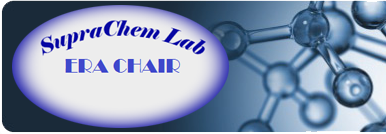
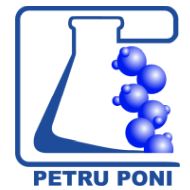
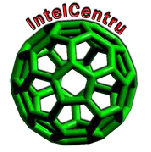
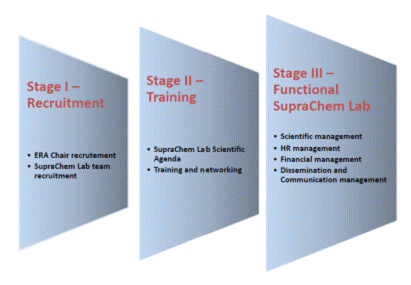
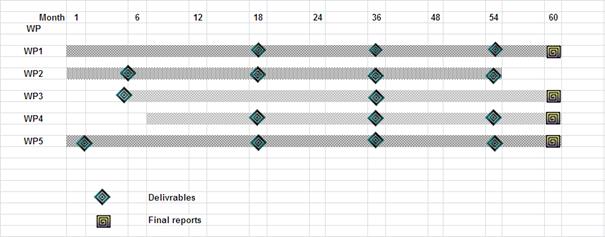
 Funded under Horizon 2020 project - SupraChem Lab - Laboratory of Supramolecular Chemistry for Adaptive Delivery Systems - ERA Chair initiative
Funded under Horizon 2020 project - SupraChem Lab - Laboratory of Supramolecular Chemistry for Adaptive Delivery Systems - ERA Chair initiative